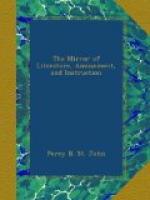The convents, however, still remained in their pristine magnificence, though declining in purity of morals and in public estimation. In place of new foundations of this august description, the—
“Village parson’s modest mansion rose,”
gracefully shewing its unostentatious front, and, at length, humbly adorning almost all the scattered villages of the land.—Bowles’s History of Bremhill.
* * * * *
It was pleasantly observed by a sentimental jockey, who lost by a considerable length the first race he ever rode, “I’ll never ride another race as long as I live. The riders are the most selfish, narrow minded creatures on the face of the earth. They kept riding and galloping as fast as they could, and never had once the kindness or civility to stop for me.”—Penelope.
* * * * *
IRELAND.
It has lately been proved by indisputable evidence, that the present condition of the peasantry of Ireland is much superior, to that of the population of the same island some centuries ago, when the number of people did not exceed one million. Spenser describes them as inhabiting “sties rather than houses, which is the chiefest cause of the farmer’s so beastly manner of living and savage condition, lying and living together with his beast, in one house, in one room, in one bed, that is clean straw, or rather a foul dunghill.”
In 1712, Dobbs, a man particularly conversant with the general condition of Ireland, estimated that its population had increased 200,000. He states that “the common people are very poorly clothed, go barelegged half the year, and very rarely taste of that flesh meat with which we so much abound, but are pinched in every article of life.”
In 1762, Sir William Petty computed that the inhabitants of Ireland amounted to about one million three hundred thousand. Their habitations, he says, “are lamentable wretched cabins, such as themselves could make in three or four days, not worth five shillings the building, and filthy and disgusting to a degree, which renders it necessary for us to refrain from quoting his description. Out of the 200,000 houses




